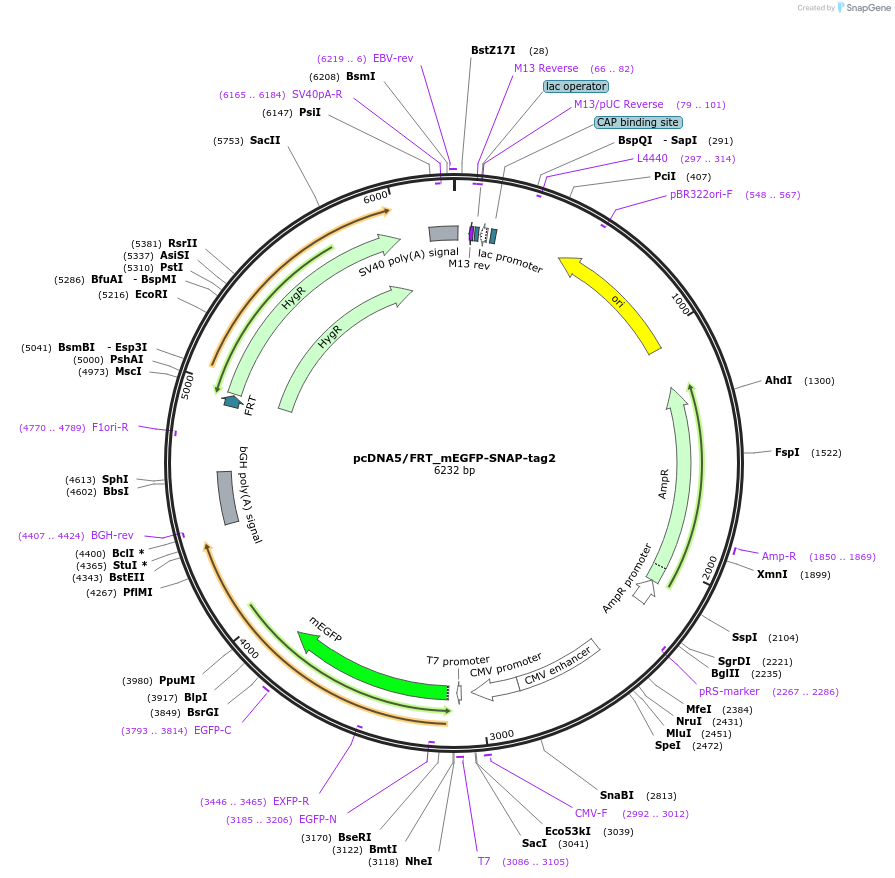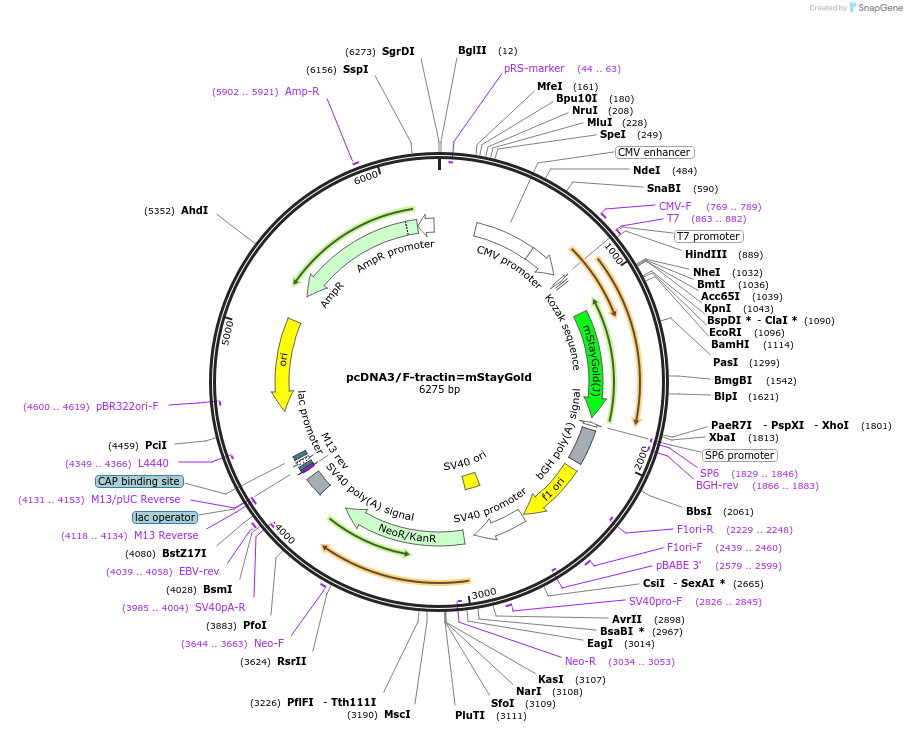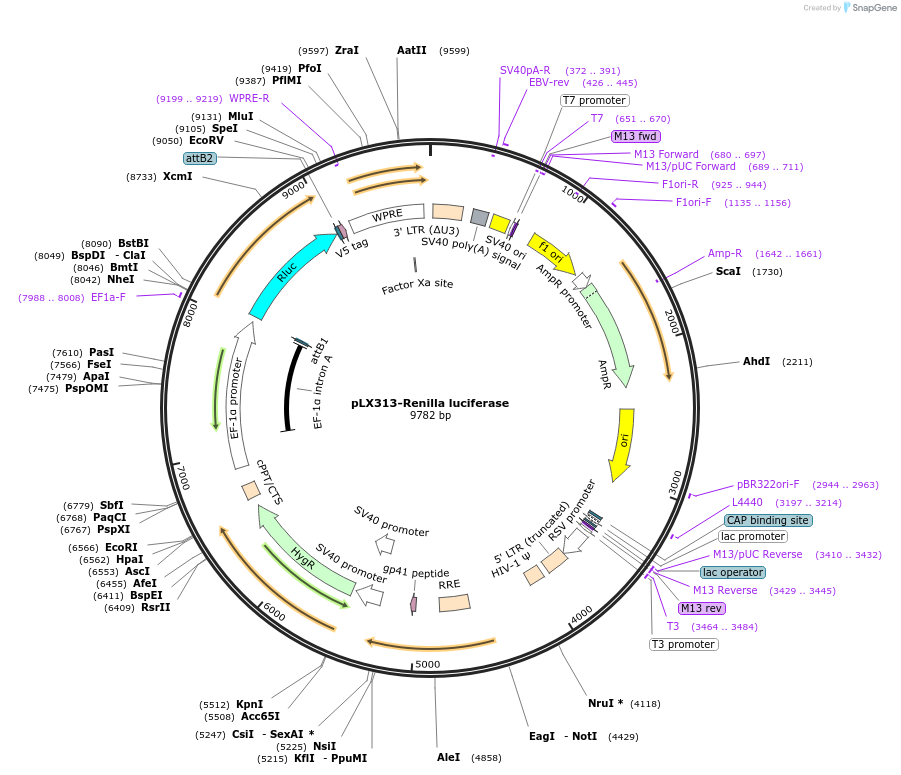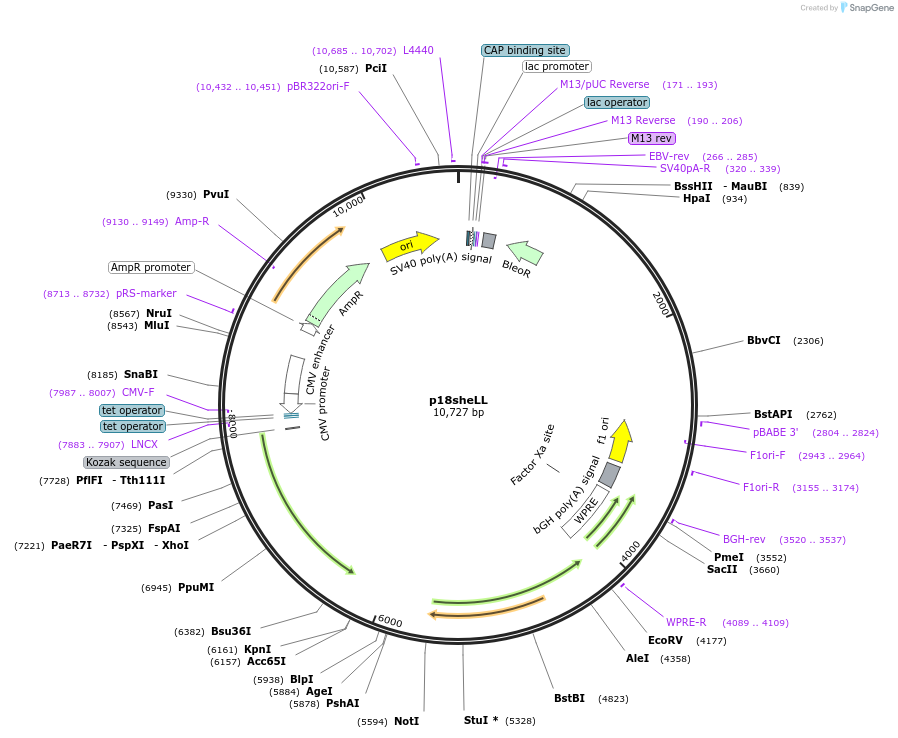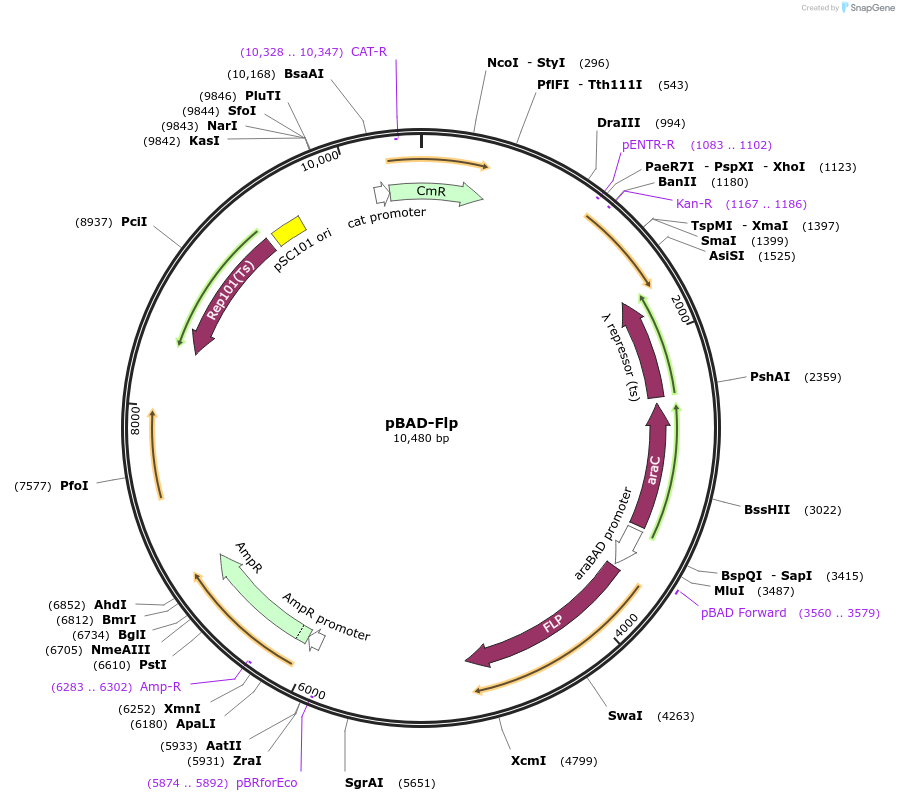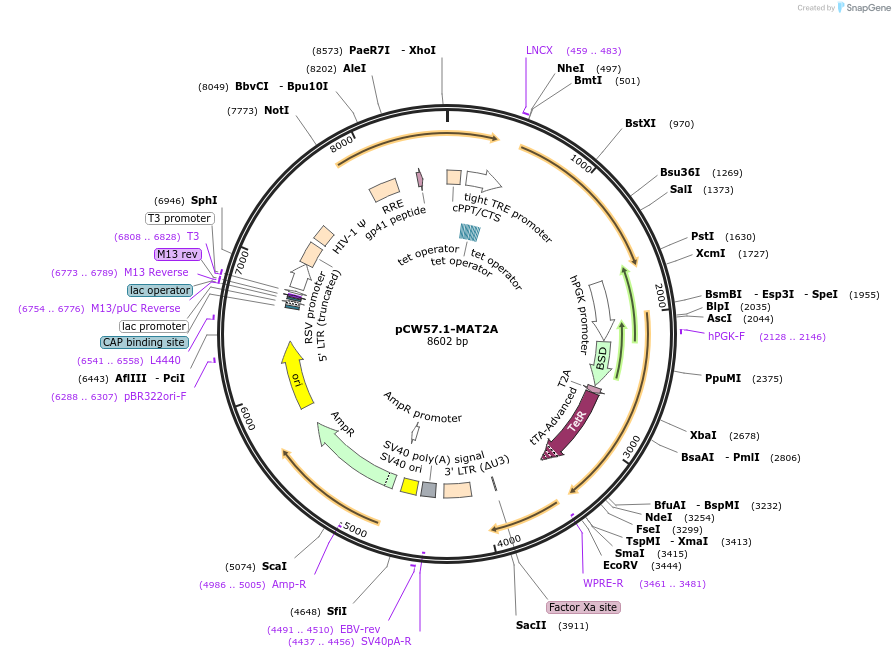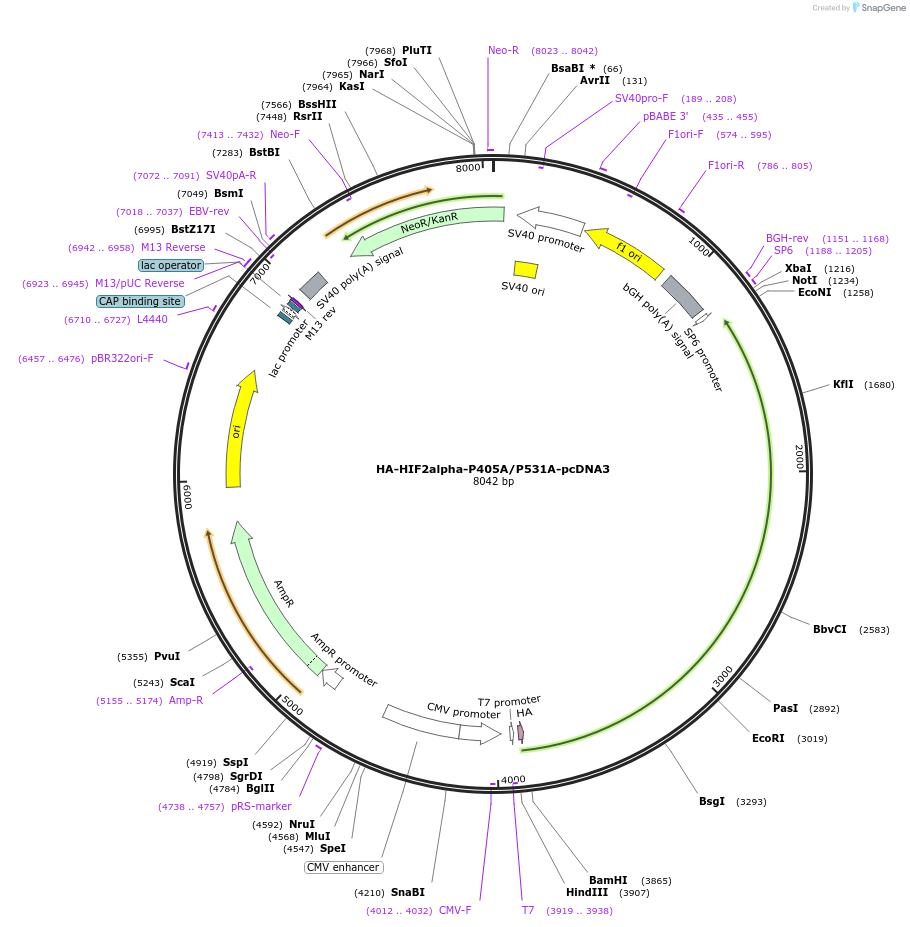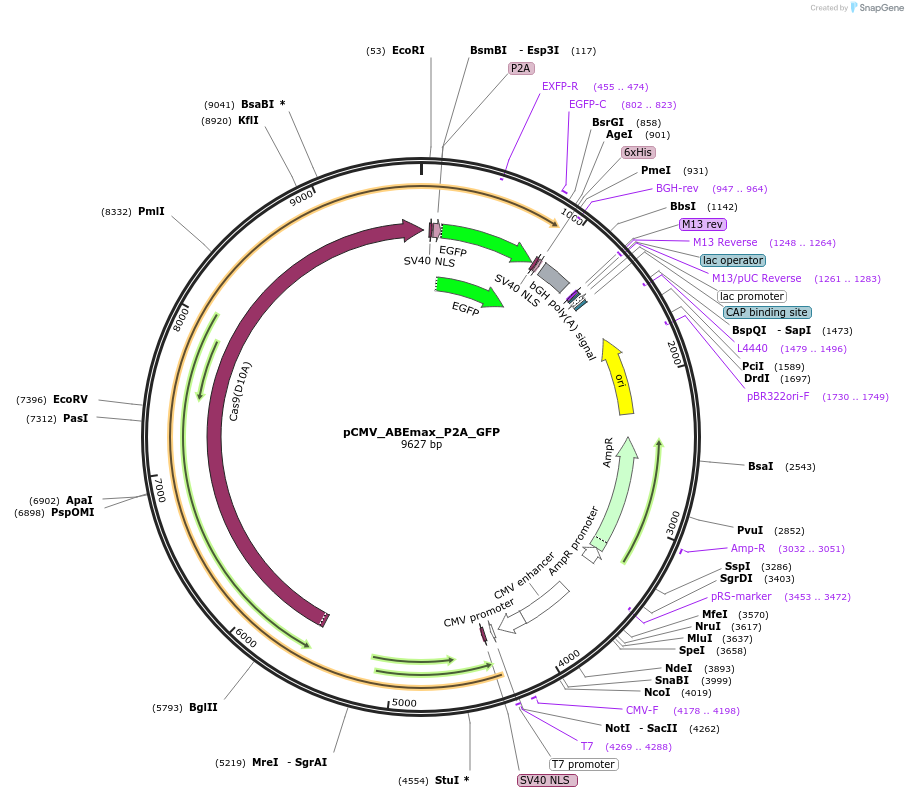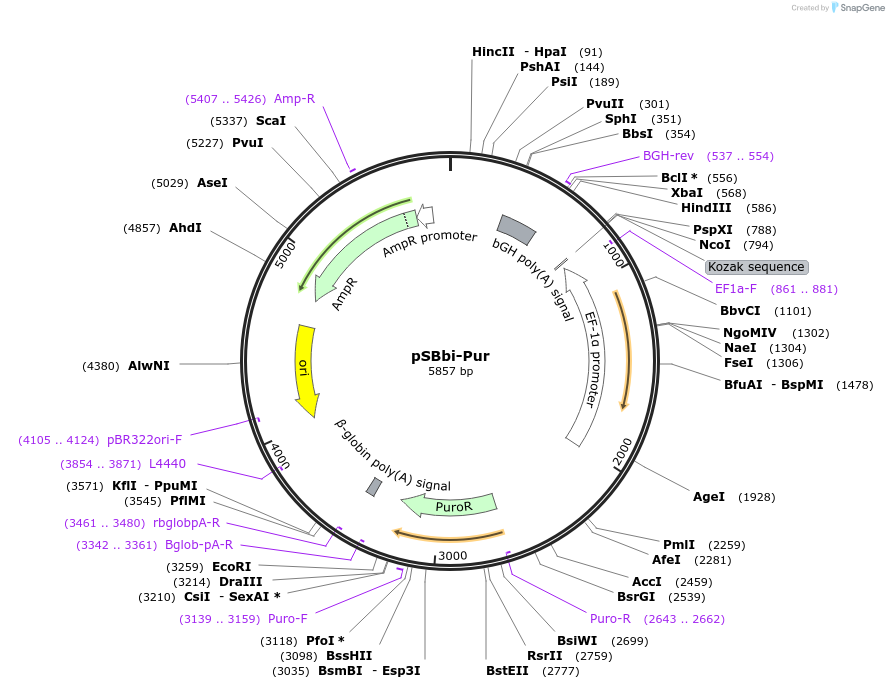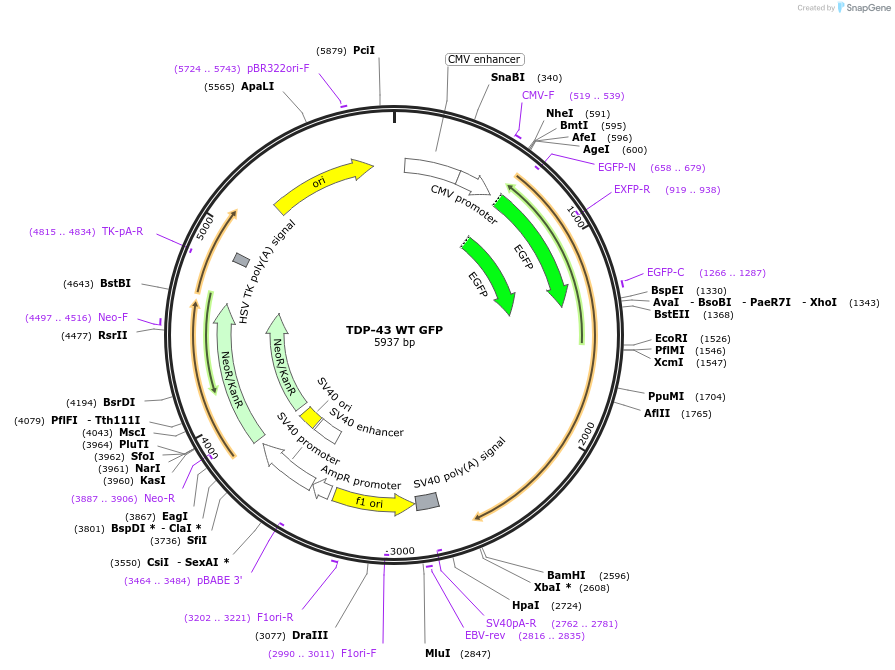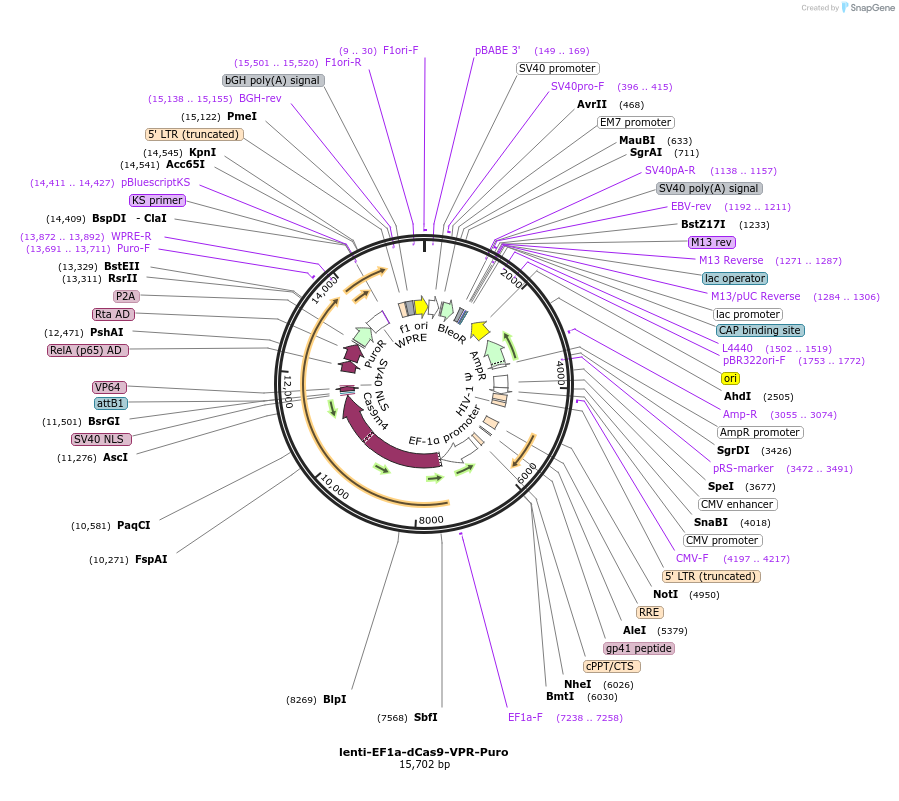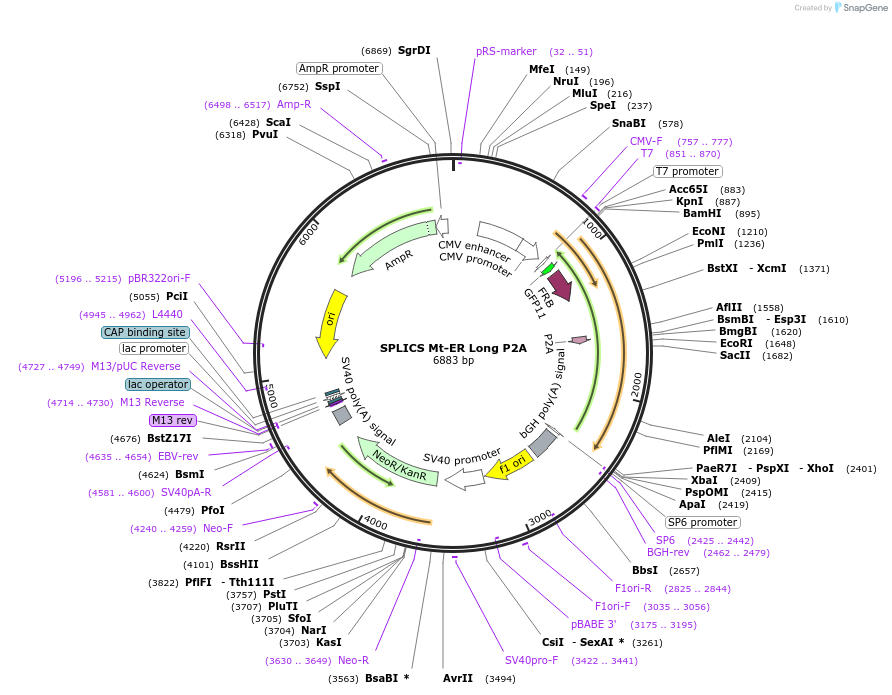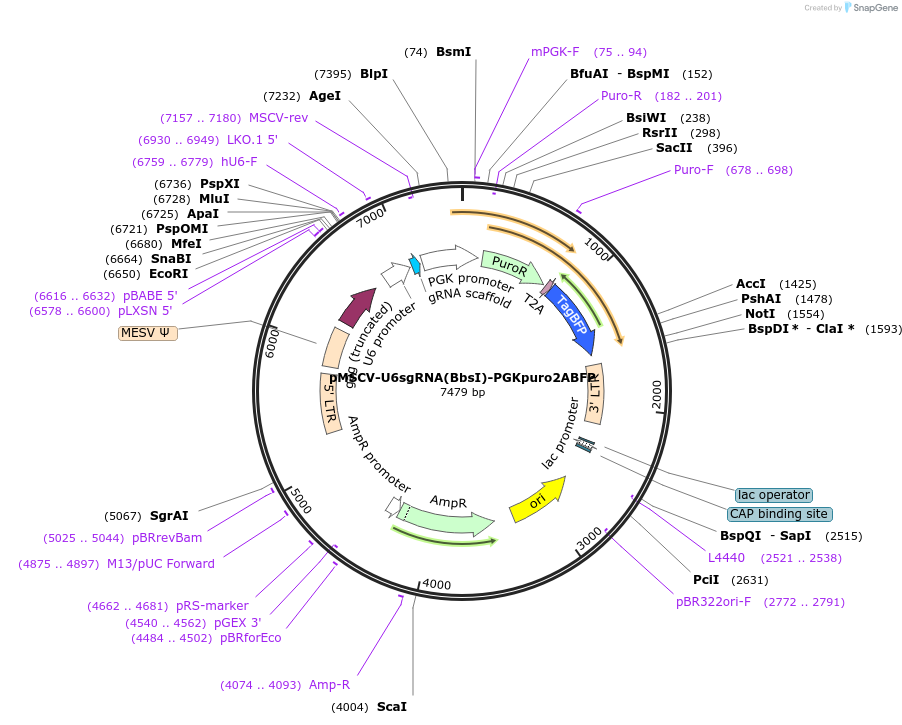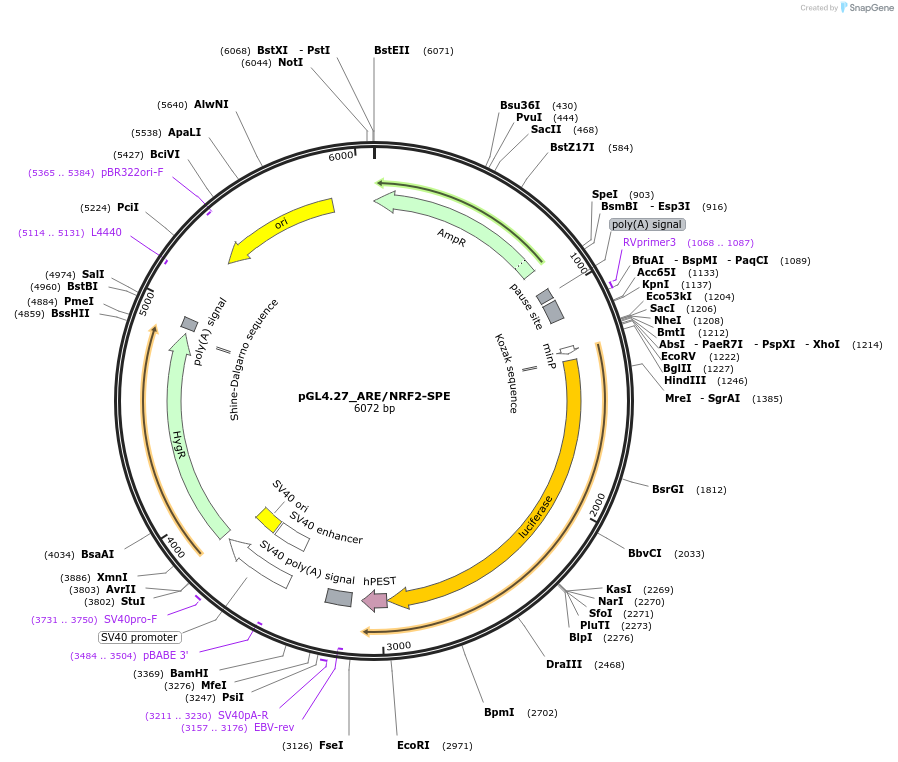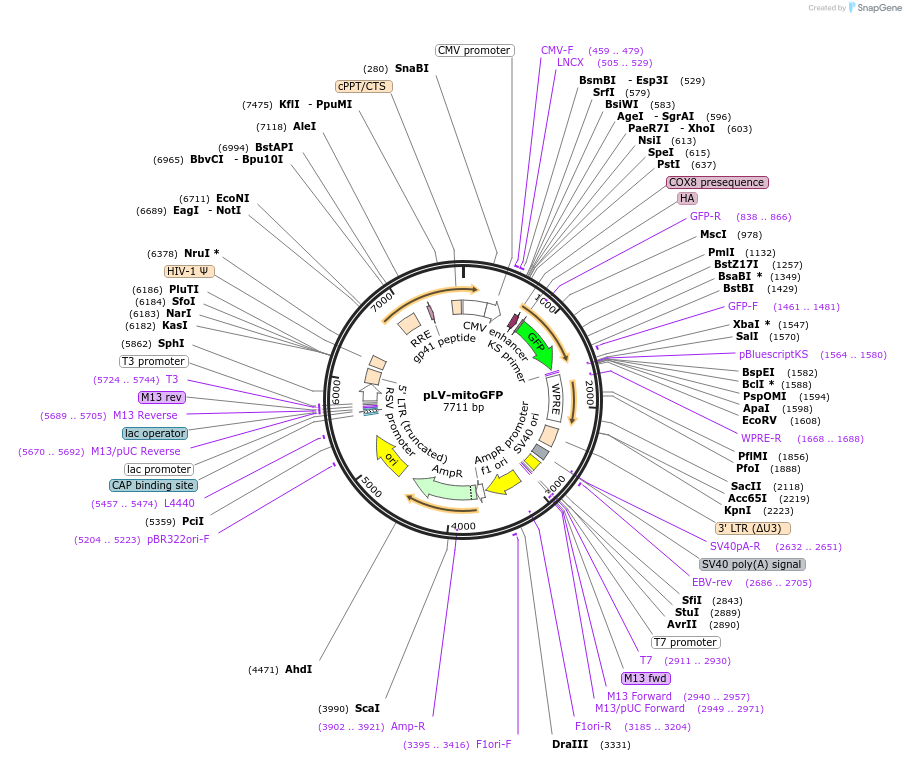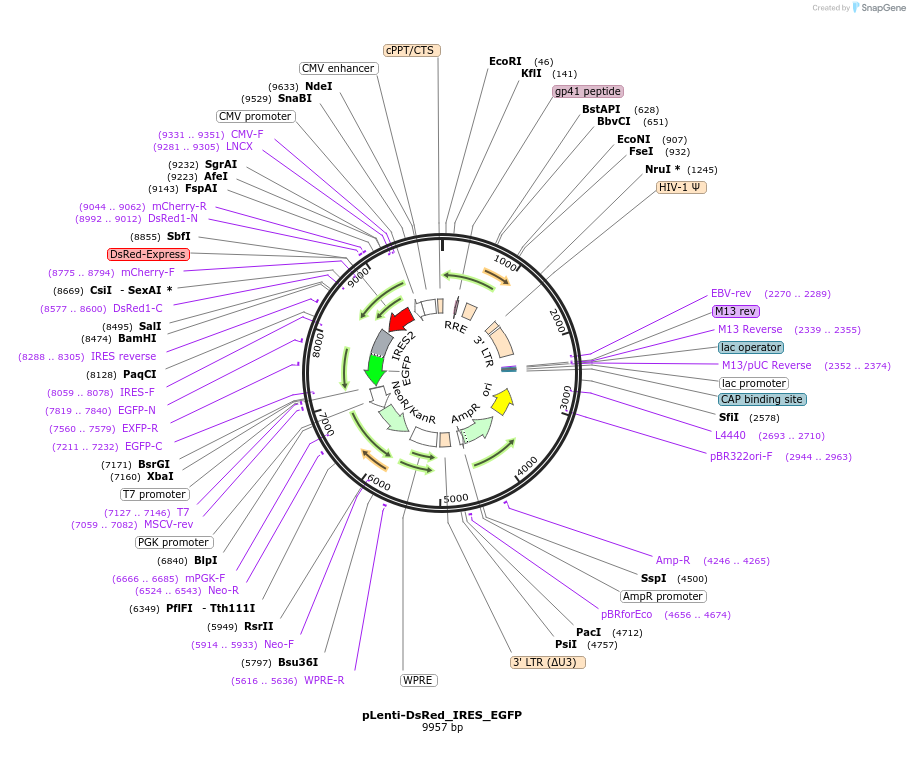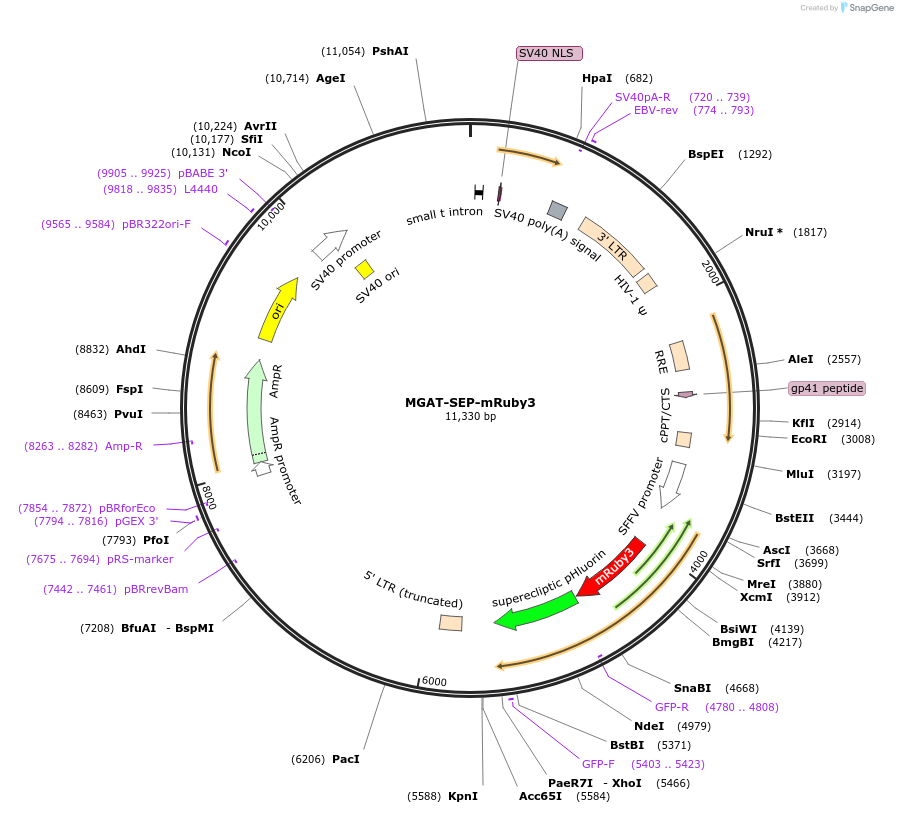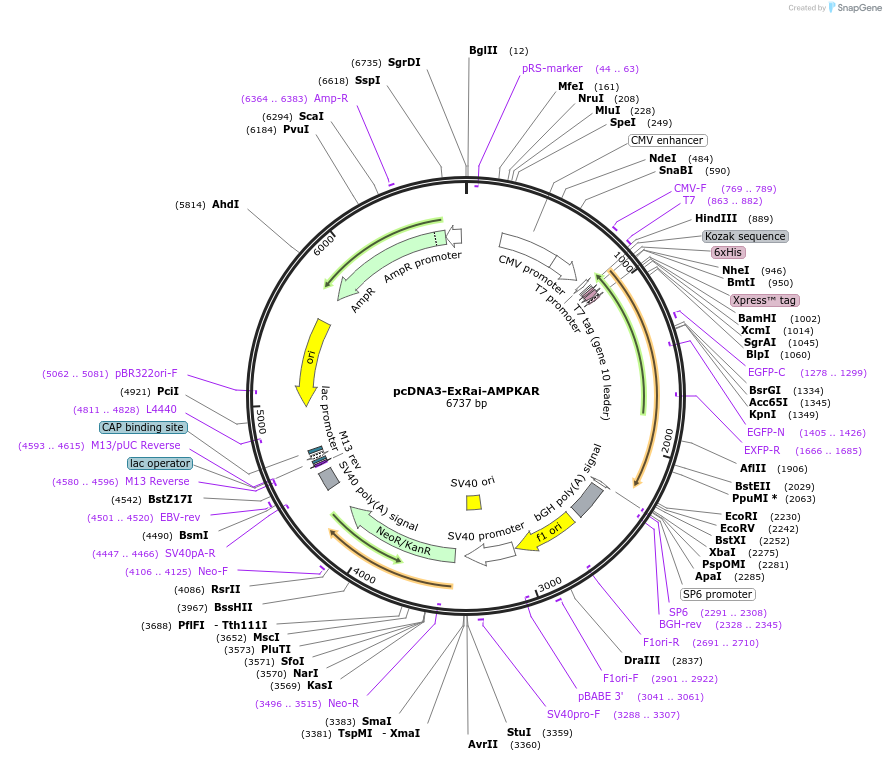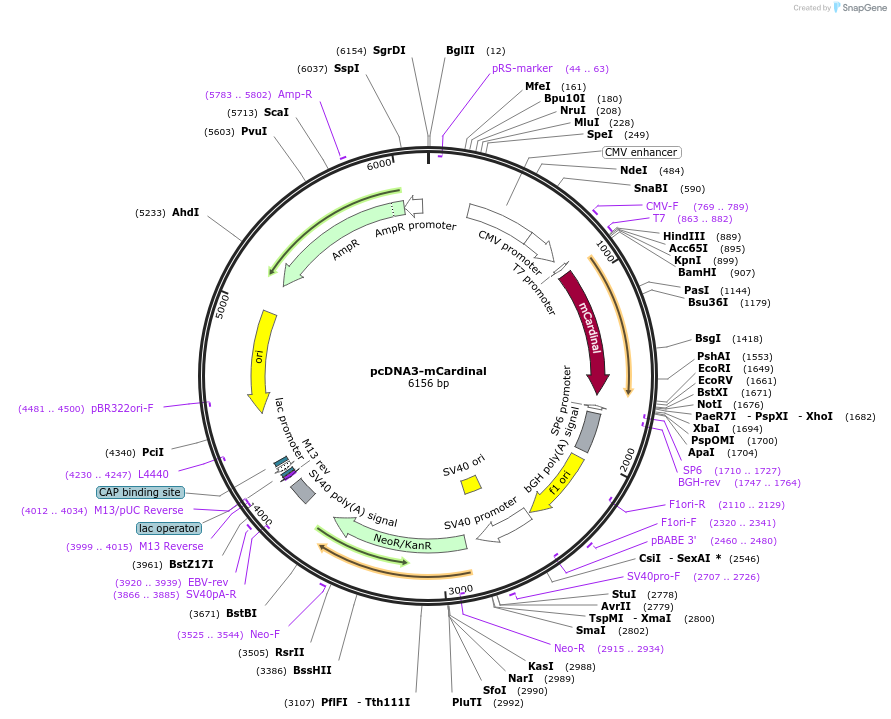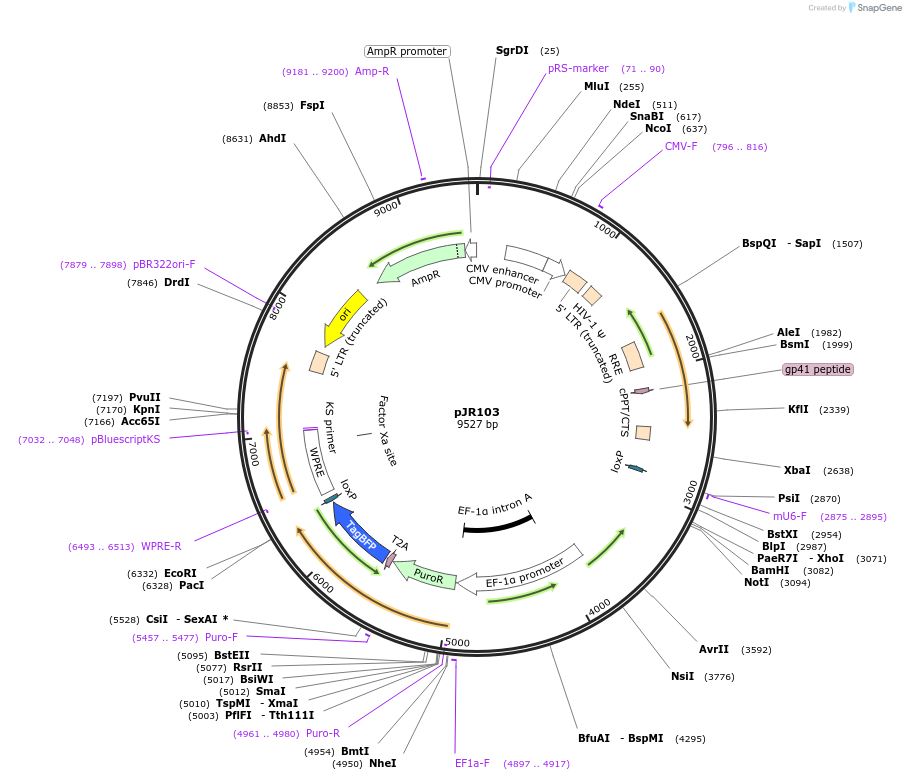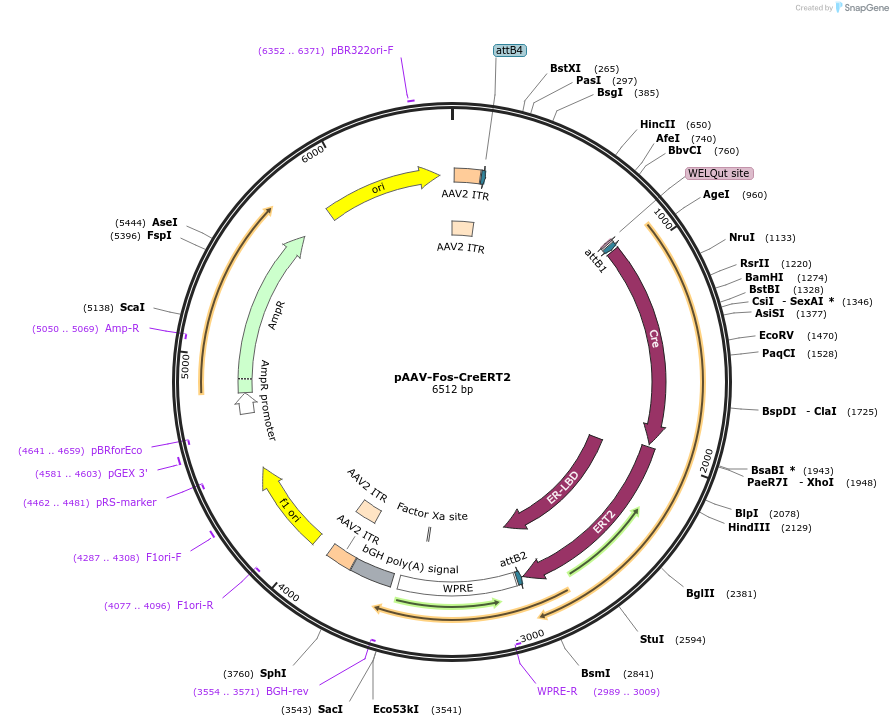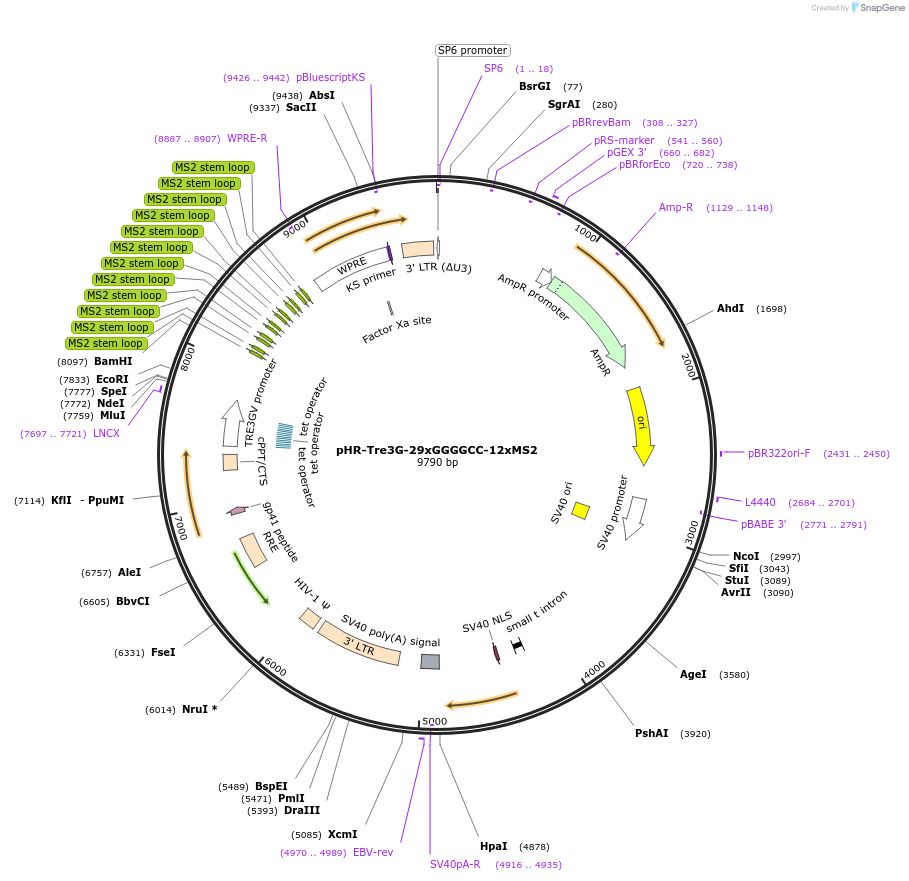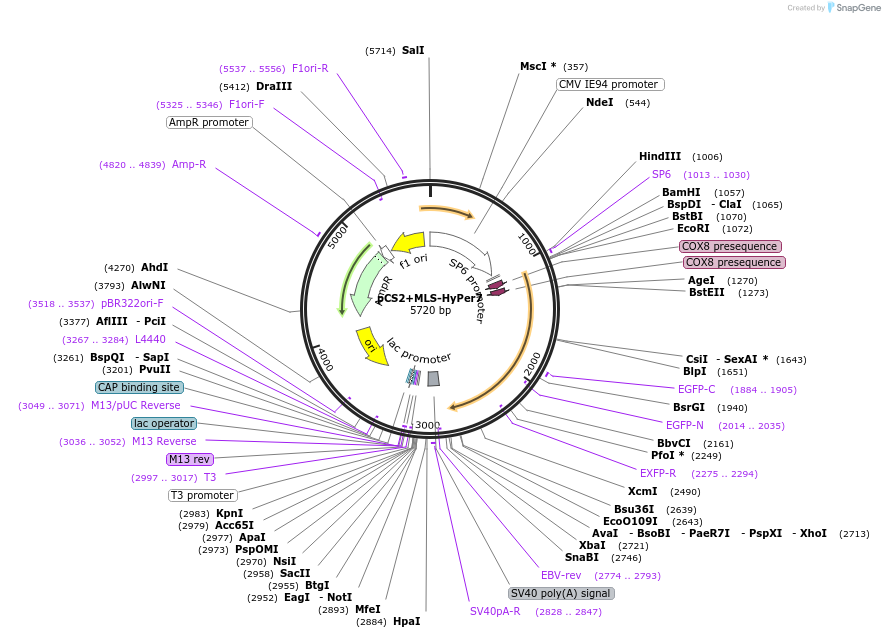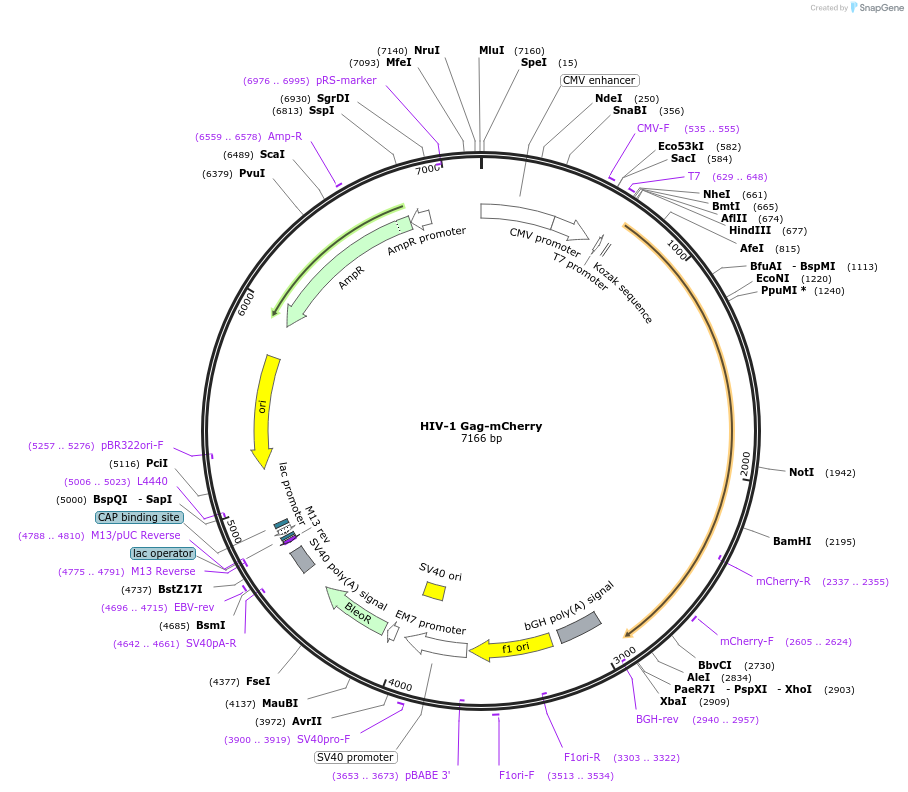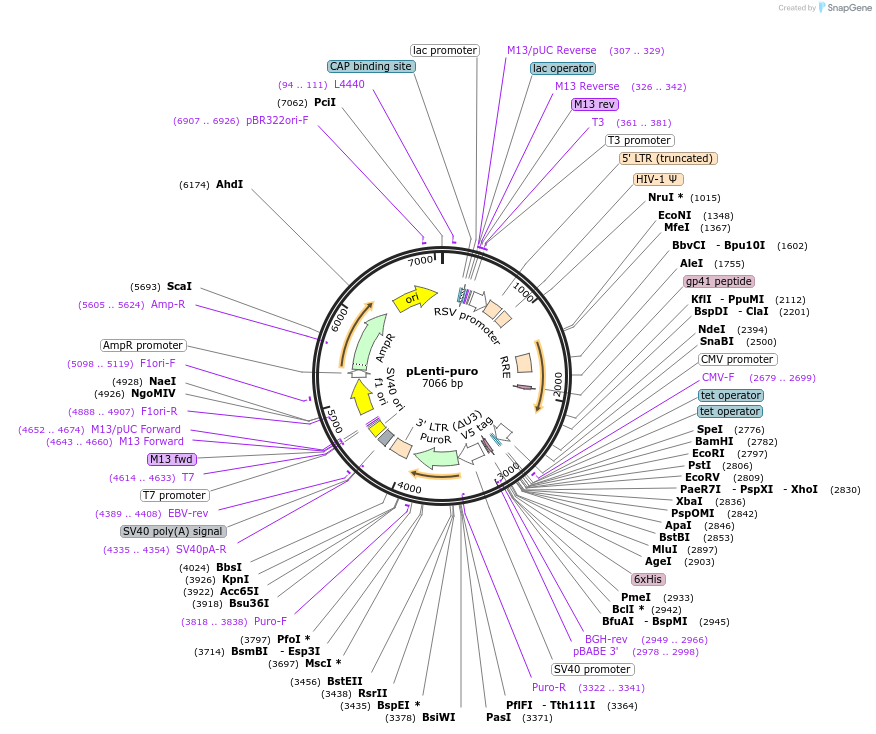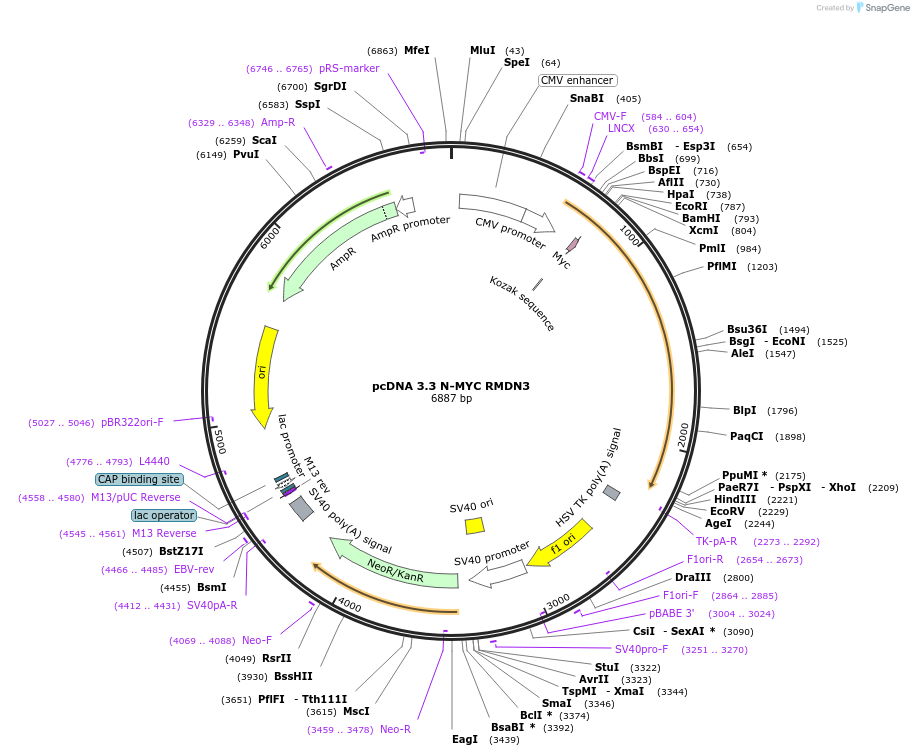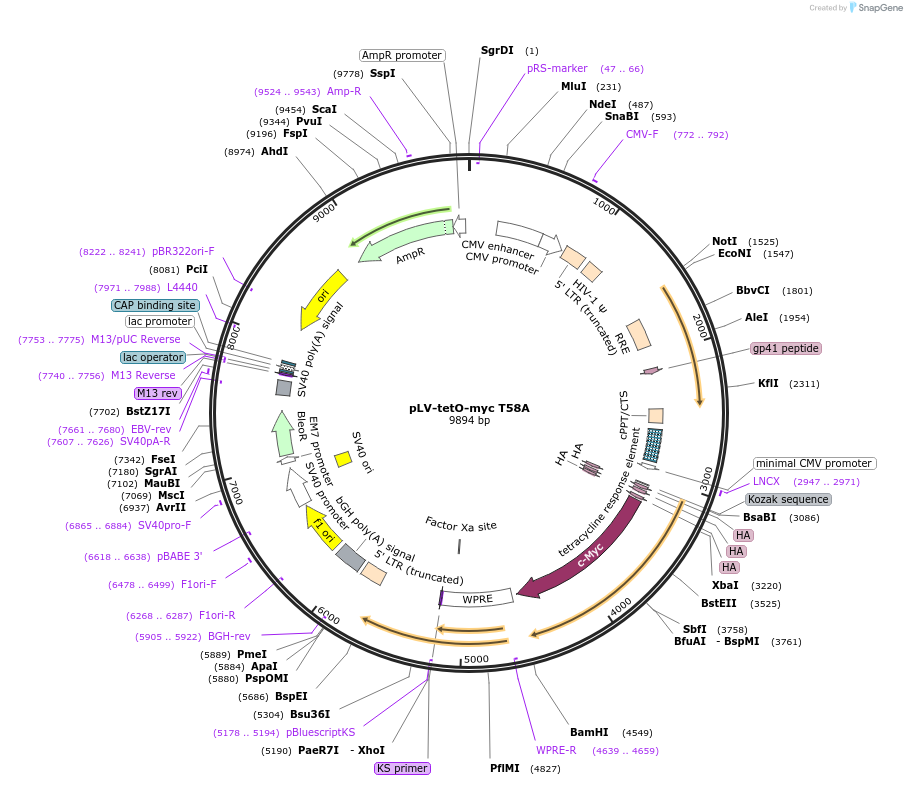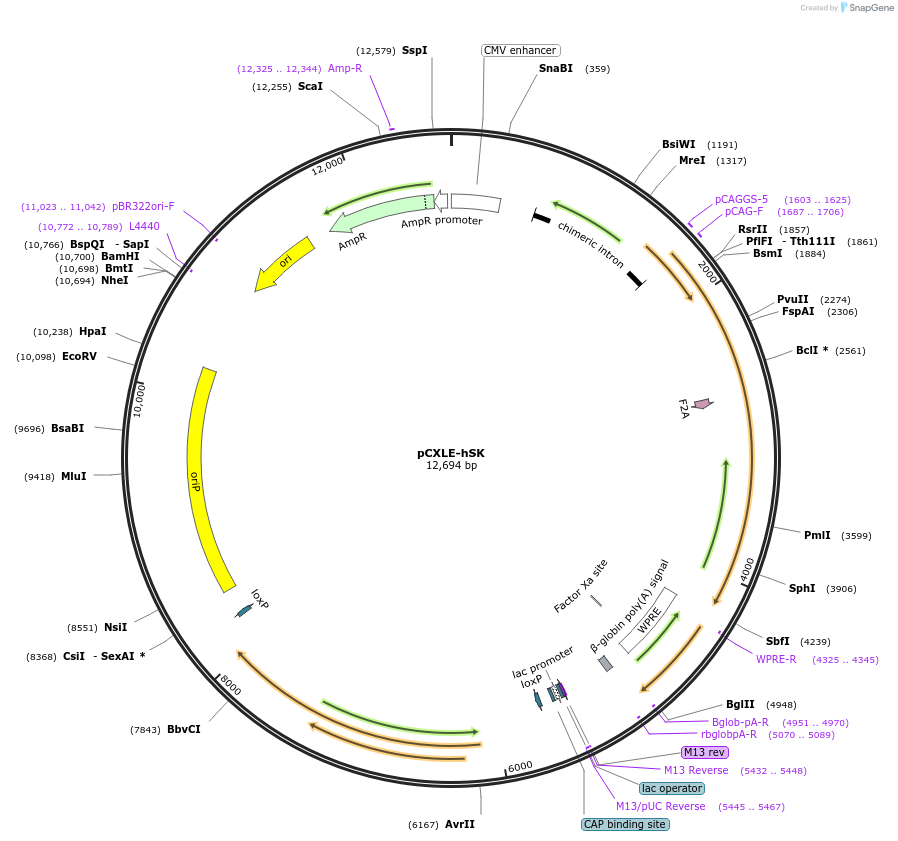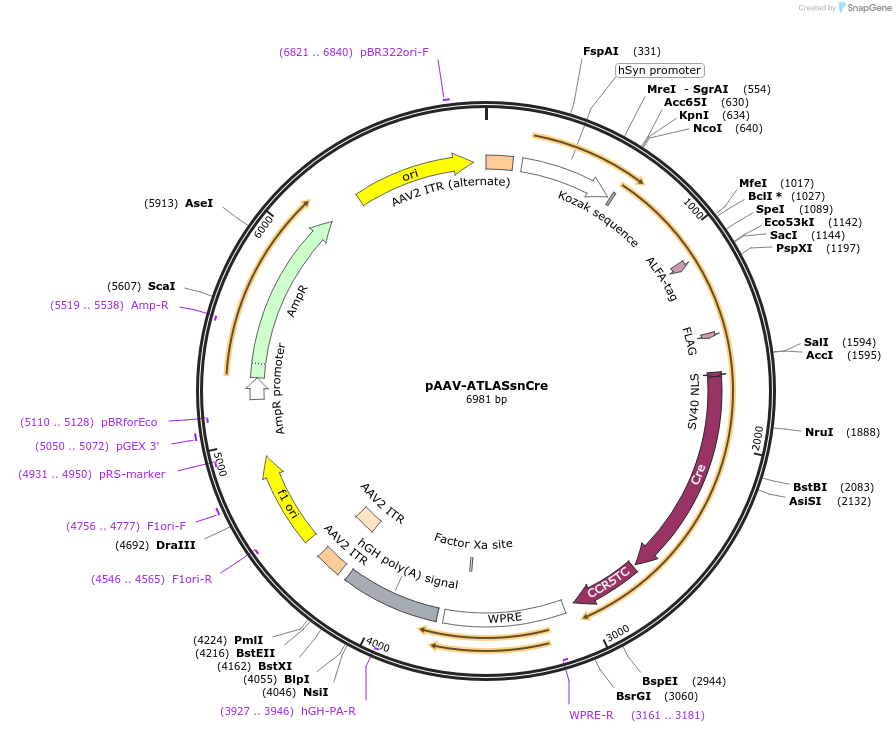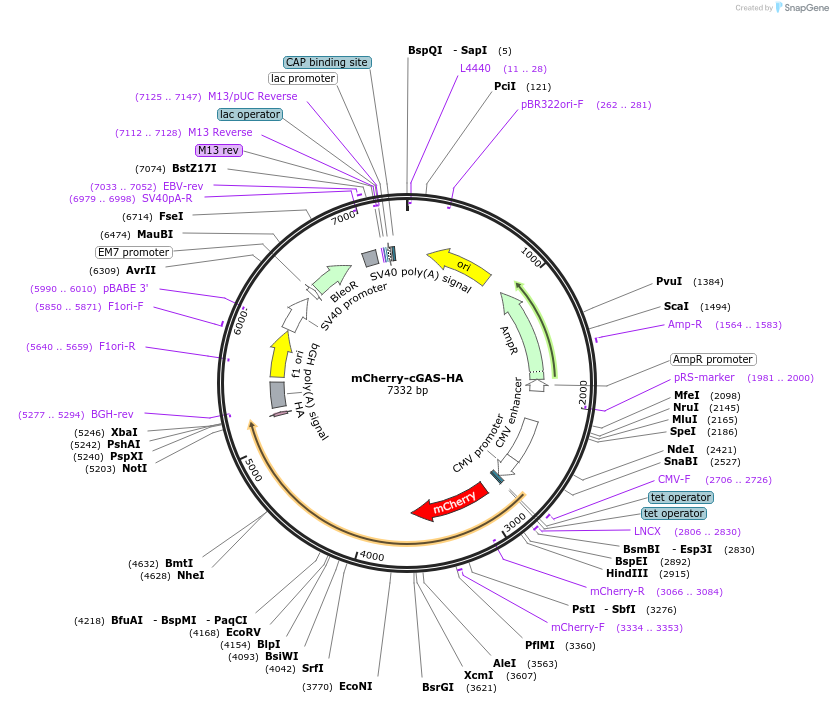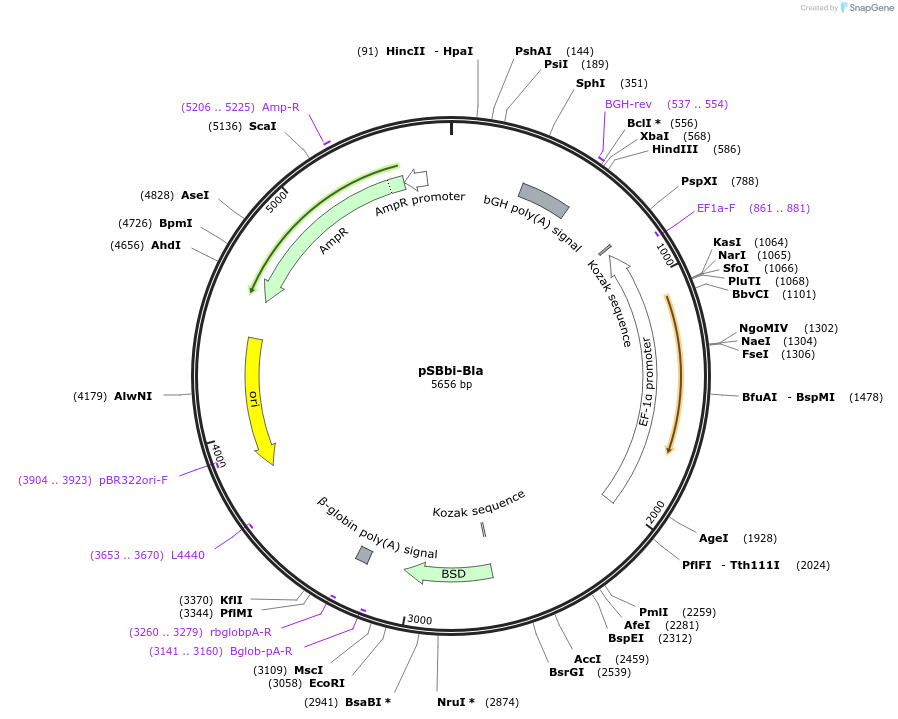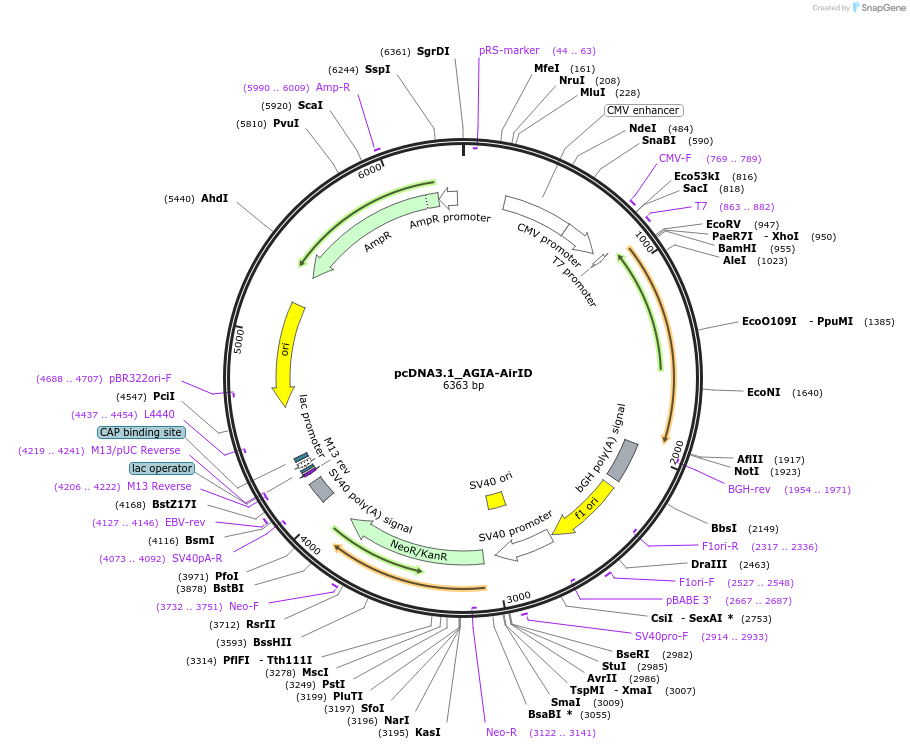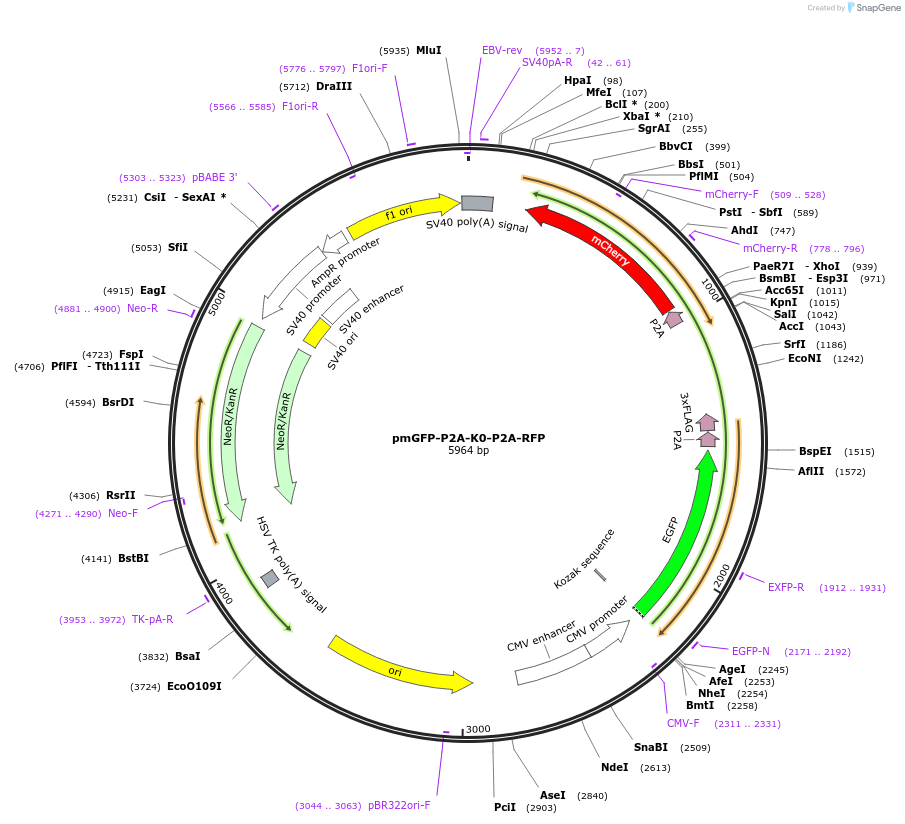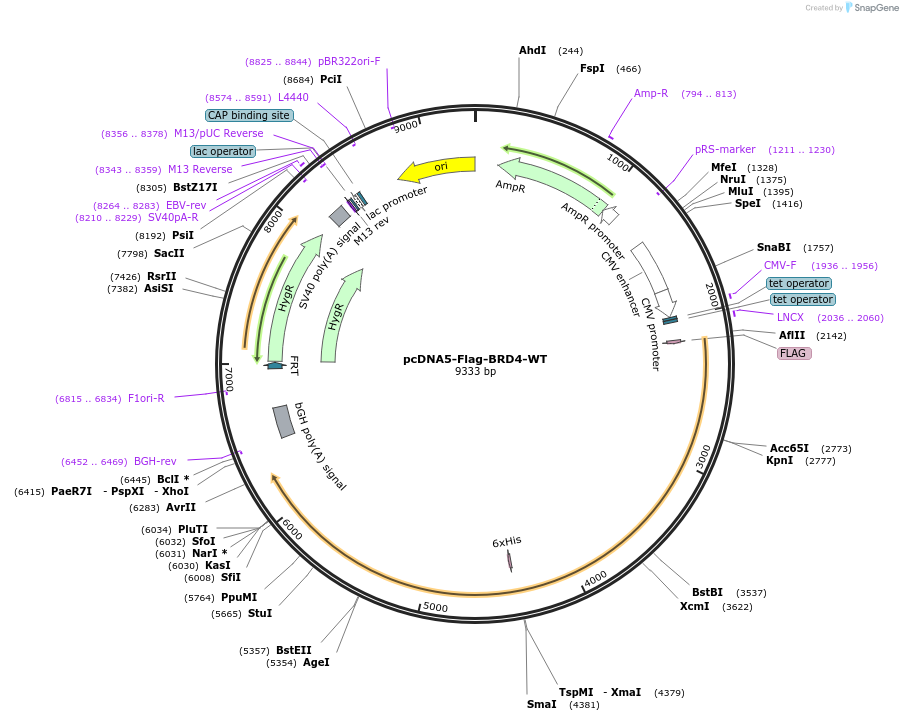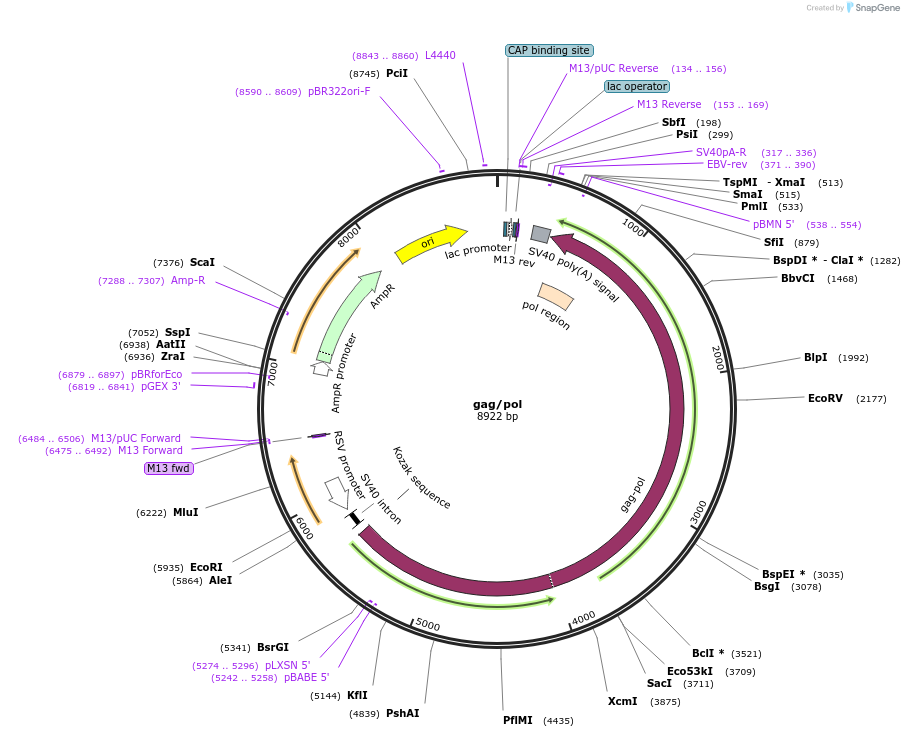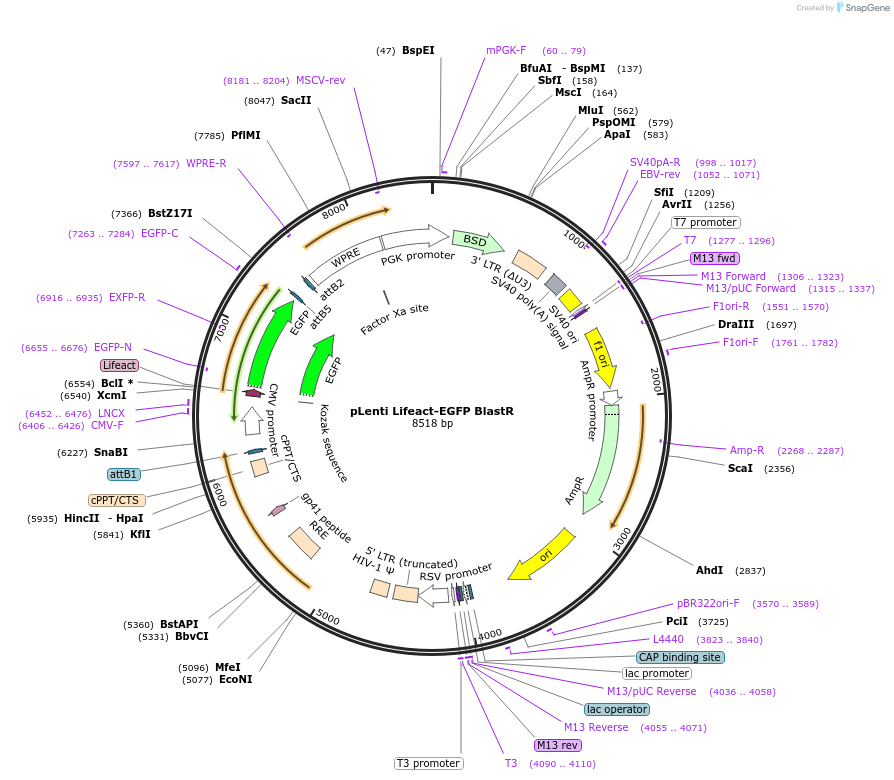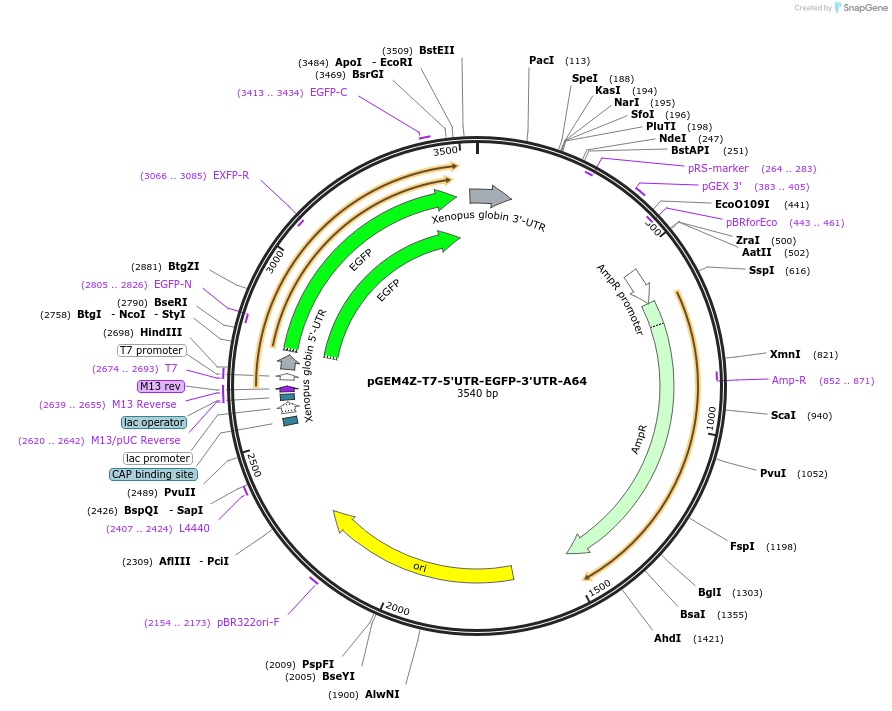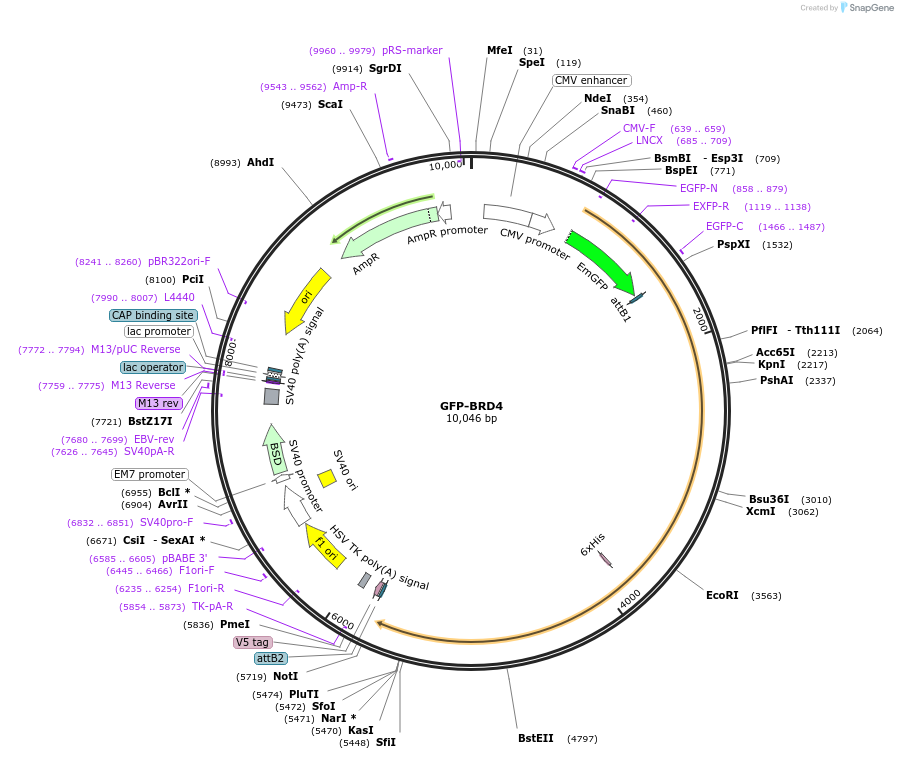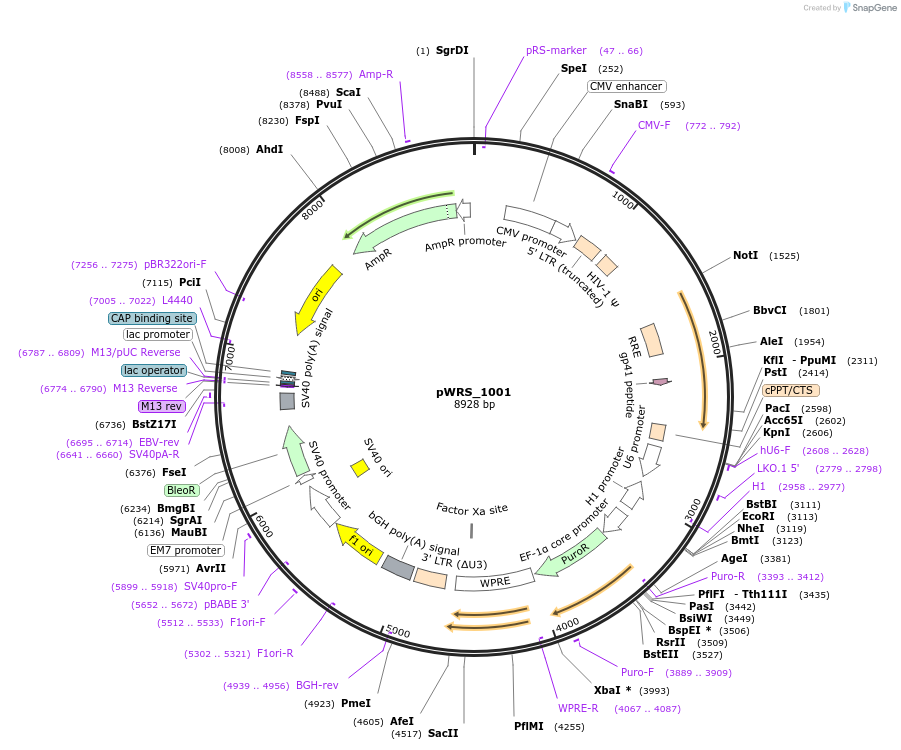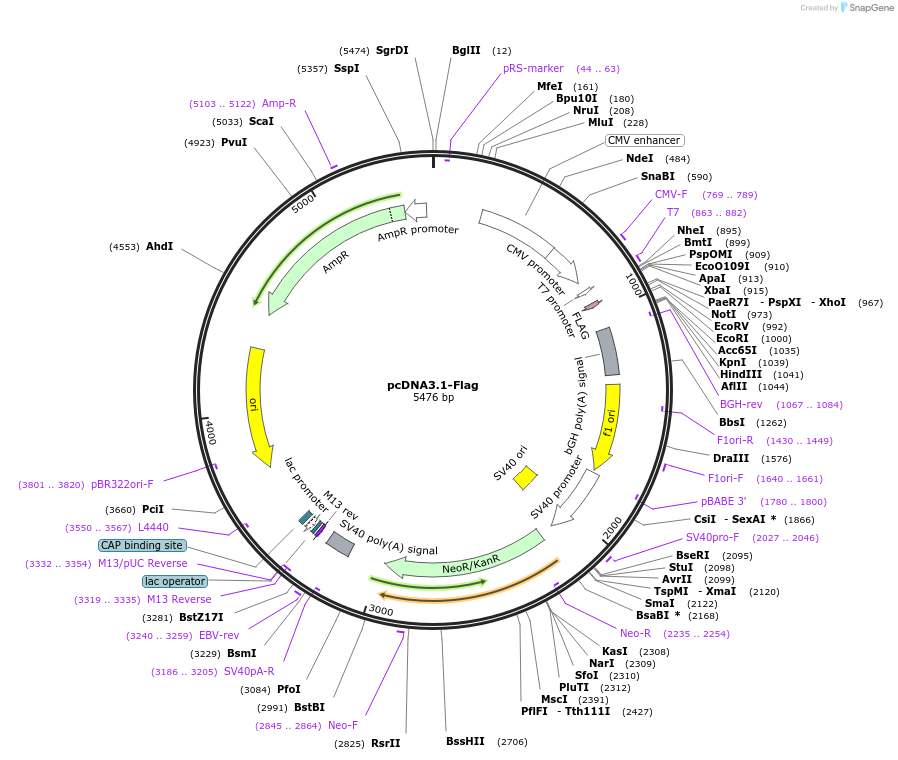169,450 results
-
Plasmid#226513PurposeMamalian cell expression of cytosolic mEGFP-SNAP-tag2DepositorInsertmEGFP-SNAP-tag2
ExpressionMammalianAvailable SinceOct. 15, 2024AvailabilityAcademic Institutions and Nonprofits only -
pcDNA3/F-tractin=mStayGold
Plasmid#212019PurposeFor filamentous actin labeling. Alternatively, the F-tractin gene can be replaced with a target molecule gene for C-terminal tagging with mStayGold through a linker [(GGGGS)3] (denoted as ‘=’).DepositorInsertF-tractin
TagsmStayGoldExpressionMammalianPromoterCMVAvailable SinceJan. 16, 2024AvailabilityAcademic Institutions and Nonprofits only -
pGP-AAV-syn-FLEX-jGCaMP8f-WPRE (AAV9)
Viral Prep#162379-AAV9PurposeReady-to-use AAV9 particles produced from pGP-AAV-syn-FLEX-jGCaMP8f-WPRE (#162379). In addition to the viral particles, you will also receive purified pGP-AAV-syn-FLEX-jGCaMP8f-WPRE plasmid DNA. Syn-driven, Cre-dependent expression of the ultrafast calcium sensor, GCaMP8f. These AAV preparations are suitable purity for injection into animals.DepositorPromoterSynAvailable SinceJune 22, 2021AvailabilityAcademic Institutions and Nonprofits only -
pLX313-Renilla luciferase
Plasmid#118016PurposeConstitutive expression of Renilla luciferaseDepositorInsertRenilla luciferase
UseLentiviralExpressionMammalianPromoterEF1alphaAvailable SinceOct. 29, 2018AvailabilityAcademic Institutions and Nonprofits only -
pENN.AAV.CamKII 0.4.Cre.SV40 (AAV5)
Viral Prep#105558-AAV5PurposeReady-to-use AAV5 particles produced from pENN.AAV.CamKII 0.4.Cre.SV40 (#105558). In addition to the viral particles, you will also receive purified pENN.AAV.CamKII 0.4.Cre.SV40 plasmid DNA. CamKII-driven Cre expression. These AAV preparations are suitable purity for injection into animals.DepositorPromoterCaMKIIAvailable SinceAug. 9, 2018AvailabilityAcademic Institutions and Nonprofits only -
p18sheLL
Plasmid#37321DepositorInsertHPV18L1+L2
ExpressionMammalianPromoterCMVAvailable SinceJuly 23, 2012AvailabilityAcademic Institutions and Nonprofits only -
pBAD-Flp
Plasmid#122969PurposeExpresses flp recombinase in bacteria upon arabinose induction. No flp activity is detected without induction.DepositorInsertFlp recombinase
ExpressionBacterialPromoterpBADAvailable SinceAug. 22, 2019AvailabilityIndustry, Academic Institutions, and Nonprofits -
pCW57.1-MAT2A
Plasmid#100521PurposeDox-repressible cDNA expression of MAT2A (dox-off/ tet-off all-in-one vector)DepositorAvailable SinceJan. 22, 2018AvailabilityAcademic Institutions and Nonprofits only -
HA-HIF2alpha-P405A/P531A-pcDNA3
Plasmid#18956DepositorInsertHypoxia inducible factor 2 alpha (EPAS1 Human)
TagsHA-tagExpressionMammalianMutationcDNA changed amino acids: Proline 405 to Alanin…Available SinceAug. 20, 2008AvailabilityAcademic Institutions and Nonprofits only -
pCMV_ABEmax_P2A_GFP
Plasmid#112101PurposeA:T-to-G:C base editingDepositorInsertABEmax_P2A_GFP
UseCRISPRExpressionMammalianPromoterCMVAvailable SinceJune 6, 2018AvailabilityAcademic Institutions and Nonprofits only -
pSBbi-Pur
Plasmid#60523PurposeSB-transposon with constitutive bi-directional promoter, one side: SfiI cloning site for GOI (contains filler DNA), other side: puromycin resistance geneDepositorTypeEmpty backboneUseTransposonExpressionMammalianPromoterEF1a/RPBSAAvailable SinceFeb. 11, 2015AvailabilityAcademic Institutions and Nonprofits only -
TDP-43 WT GFP
Plasmid#237542PurposeExpression of GFP-tag fused to wild-type TDP-43DepositorInsertGFP-tagged TDP-43 WT (TARDBP Human)
TagsEGFPExpressionMammalianMutationwild-type TDP-43PromoterCMVAvailable SinceMay 13, 2025AvailabilityAcademic Institutions and Nonprofits only -
lenti-EF1a-dCas9-VPR-Puro
Plasmid#99373Purpose3rd generation lenti vector encoding dCas9 (S. pyogenes) fused with VP64-p65-Rta (VPR) and 2A puromycin resistance marker; EF1a-dCas9-VPR-P2A-Puro-WPRE)DepositorInsert(Sp)dCas9-VPR-P2A-Puro
UseCRISPR and LentiviralExpressionMammalianPromoterEF-1aAvailable SinceAug. 18, 2017AvailabilityAcademic Institutions and Nonprofits only -
pAAV-nEF-Con/Foff 2.0-ChRmine-oScarlet (AAV8)
Viral Prep#137161-AAV8PurposeReady-to-use AAV8 particles produced from pAAV-nEF-Con/Foff 2.0-ChRmine-oScarlet (#137161). In addition to the viral particles, you will also receive purified pAAV-nEF-Con/Foff 2.0-ChRmine-oScarlet plasmid DNA. nEF-driven expression of ChRmine-oScarlet in the presence of Cre (inhibited in the presence of Flp). These AAV preparations are suitable purity for injection into animals.DepositorPromoternEFTagsoScarlet (Cre-dependent)Available SinceOct. 14, 2020AvailabilityAcademic Institutions and Nonprofits only -
SPLICS Mt-ER Long P2A
Plasmid#164107PurposeDetect the long Mitochondria-Endoplasmic reticulum contactDepositorInsertSplit GFP Mt-ER Long P2A
ExpressionMammalianAvailable SinceJan. 25, 2021AvailabilityAcademic Institutions and Nonprofits only -
pMSCV-U6sgRNA(BbsI)-PGKpuro2ABFP
Plasmid#102796PurposeRetrovirus for delivery of one sgRNA (empty, bbsI)DepositorInsertU6 sgRNA
UseCRISPR and RetroviralExpressionMammalianPromoterU6Available SinceAug. 6, 2019AvailabilityAcademic Institutions and Nonprofits only -
pGP-AAV-syn-FLEX-jGCaMP8s-WPRE (AAV9)
Viral Prep#162377-AAV9PurposeReady-to-use AAV9 particles produced from pGP-AAV-syn-FLEX-jGCaMP8s-WPRE (#162377). In addition to the viral particles, you will also receive purified pGP-AAV-syn-FLEX-jGCaMP8s-WPRE plasmid DNA. Syn-driven, Cre-dependent expression of calcium sensor GCaMP8s (more sensitive). These AAV preparations are suitable purity for injection into animals.DepositorPromoterSynAvailable SinceMay 19, 2021AvailabilityAcademic Institutions and Nonprofits only -
pGL4.27_ARE/NRF2-SPE
Plasmid#177775PurposeLuciferase reporter for ARE/NRF2DepositorInsertNRF2 (NFE2L2 Human)
UseLuciferaseAvailable SinceApril 5, 2022AvailabilityAcademic Institutions and Nonprofits only -
pLV-mitoGFP
Plasmid#44385DepositorInsertmitoGFP (COX8A Human)
UseLentiviralTagsCox8 targeting sequence and GFPExpressionMammalianPromoterCMVAvailable SinceJune 12, 2015AvailabilityAcademic Institutions and Nonprofits only -
pLenti-DsRed_IRES_EGFP
Plasmid#92194PurposeLentiviral overexpression vector to make stable bicistronic cell line for control (EGFP) screenDepositorInsertDsRed-IRES-EGFP
UseLentiviralExpressionMammalianAvailable SinceJune 26, 2017AvailabilityAcademic Institutions and Nonprofits only -
pAAV-Ef1a-fDIO mCherry (AAV5)
Viral Prep#114471-AAV5PurposeReady-to-use AAV5 particles produced from pAAV-Ef1a-fDIO mCherry (#114471). In addition to the viral particles, you will also receive purified pAAV-Ef1a-fDIO mCherry plasmid DNA. Ef1a-driven, Flp recombinase-dependent expression of mCherry. These AAV preparations are suitable purity for injection into animals.DepositorPromoterEF1aTagsmCherry (Flp-dependent)Available SinceJan. 10, 2020AvailabilityAcademic Institutions and Nonprofits only -
MGAT-SEP-mRuby3
Plasmid#200937Purposecis/medial golgi localized pH sensor using sensorsuperecliptic pHluorin (SEP) and mRuby3DepositorInsertsUseLentiviralAvailable SinceSept. 14, 2023AvailabilityAcademic Institutions and Nonprofits only -
pcDNA3-ExRai-AMPKAR
Plasmid#192446PurposeGenetically encoded excitation-ratiometric fluorescent biosensor for monitoring AMPK activity in living cells.DepositorInsertExRai-AMPKAR
Tags6xHIS - T7 tag (gene 10 leader) - Xpress (TM) tagExpressionMammalianPromoterCMVAvailable SinceDec. 7, 2022AvailabilityAcademic Institutions and Nonprofits only -
pcDNA3-mCardinal
Plasmid#51311PurposeExpresses far-red fluorescent protein mCardinal in mammalian cellsDepositorInsertmCardinal
ExpressionMammalianPromoterCMVAvailable SinceApril 8, 2014AvailabilityAcademic Institutions and Nonprofits only -
MORF Library Kit with GFP and mCherry controls
Pooled Library#1000000218DepositorAvailable SinceMarch 24, 2023AvailabilityAcademic Institutions and Nonprofits only -
pAAV-hSyn-DIO-ChrimsonR-mRuby2-ST (AAV9)
Viral Prep#105448-AAV9PurposeReady-to-use AAV9 particles produced from pAAV-hSyn-DIO-ChrimsonR-mRuby2-ST (#105448). In addition to the viral particles, you will also receive purified pAAV-hSyn-DIO-ChrimsonR-mRuby2-ST plasmid DNA. hSyn-driven expression of ChrimsonR fused to mRuby2 fluorophore and targeted to the neuronal soma and proximal dendrites for optogenetic activation. These AAV preparations are suitable purity for injection into animals.DepositorPromoterSynTagsmRuby2Available SinceSept. 12, 2018AvailabilityAcademic Institutions and Nonprofits only -
pJR103
Plasmid#187242PurposeLentiviral sgRNA vector with mU6 sgRNA promoter, CR1 constant region, and UCOE EF1alpha driving PURO-BFP marker expressionDepositorInsertLentiviral sgRNA vector with mU6 sgRNA promoter, CR1 constant region, and UCOE EF1alpha driving PURO-BFP marker expression
UseLentiviralAvailable SinceOct. 19, 2022AvailabilityAcademic Institutions and Nonprofits only -
pAAV-Fos-CreERT2
Plasmid#194643PurposeExpresses Cre-ERT2 under the control of c-Fos promoterDepositorInsertFos-CreERT2
UseAAVExpressionMammalianAvailable SinceJan. 13, 2023AvailabilityAcademic Institutions and Nonprofits only -
pAAV-FLEX-tdTomato (AAV PHP.S)
Viral Prep#28306-PHP.SPurposeReady-to-use AAV PHP.S particles produced from pAAV-FLEX-tdTomato (#28306). In addition to the viral particles, you will also receive purified pAAV-FLEX-tdTomato plasmid DNA. CAG-driven, Cre-dependent tdTomato expression control. These AAV were produced with the PHP.S serotype, which permits efficient transduction of the peripheral nervous system. These AAV preparations are suitable purity for injection into animals.DepositorPromoterCAGTagstdTomato (Cre-dependent)Available SinceMarch 26, 2018AvailabilityAcademic Institutions and Nonprofits only -
pHR-Tre3G-29xGGGGCC-12xMS2
Plasmid#99149PurposeEncodes 29xGGGGCC repeats with 12xMS2 tag, 2nd generation lentiviral vector. *Please see comments section below about the number of verified repeats.DepositorInsert29xGGGGCC 12xMS2 hairpins
UseLentiviralExpressionMammalianPromoterTRE3GAvailable SinceAug. 9, 2017AvailabilityAcademic Institutions and Nonprofits only -
pCS2+MLS-HyPer7
Plasmid#136470PurposeMammalian expression of mitochondrial matrix targeted ultrasensitive hydrogen peroxide indicator HyPer7 for optical imagingDepositorInsertHyPer7
TagsTandem mitochondrial targeting signal of cytochro…ExpressionMammalianPromoterCMV, SP6Available SinceFeb. 11, 2020AvailabilityAcademic Institutions and Nonprofits only -
pGP-AAV-syn-jGCaMP7s-WPRE (AAV1)
Viral Prep#104487-AAV1PurposeReady-to-use AAV1 particles produced from pGP-AAV-syn-jGCaMP7s-WPRE (#104487). In addition to the viral particles, you will also receive purified pGP-AAV-syn-jGCaMP7s-WPRE plasmid DNA. Synapsin-driven GCaMP7s calcium sensor. These AAV preparations are suitable purity for injection into animals.DepositorPromoterSynAvailable SinceJuly 11, 2018AvailabilityAcademic Institutions and Nonprofits only -
HIV-1 Gag-mCherry
Plasmid#85390PurposeVisualization marker for viral core to measure cellular uptakeDepositorInsertHIV-1 gag
TagsmCherryExpressionMammalianPromoterCMVAvailable SinceJan. 23, 2017AvailabilityAcademic Institutions and Nonprofits only -
pLenti-puro
Plasmid#39481PurposeTetracycline inducible 3rd generation lentiviral vectorDepositorHas ServiceCloning Grade DNATypeEmpty backboneUseLentiviralTagsV5 and 6XHisExpressionMammalianPromoterCMVAvailable SinceSept. 13, 2012AvailabilityAcademic Institutions and Nonprofits only -
pcDNA 3.3 N-MYC RMDN3
Plasmid#227878PurposeUsed for transfection of cells for expression of C-MYC RMDN3DepositorAvailable SinceJuly 8, 2025AvailabilityAcademic Institutions and Nonprofits only -
pLV-tetO-myc T58A
Plasmid#19763DepositorAvailable SinceFeb. 23, 2009AvailabilityAcademic Institutions and Nonprofits only -
pCXLE-hSK
Plasmid#27078PurposeIntegration-free (episomal) expression of human SOX2 and KLF4DepositorAvailable SinceJan. 27, 2011AvailabilityAcademic Institutions and Nonprofits only -
pAAV-ATLASsnCre
Plasmid#232351PurposeAnterograde transsynaptic tracer protein to express in presynaptic glutamatergic neurons, Cre payload. Must use with AAV8-DIO-Reporter viruses infected in postsynaptic cells.DepositorHas ServiceAAV5InsertATLASsnCre
UseAAVTagsALFA-TagPromoterhSynAvailable SinceMay 5, 2025AvailabilityAcademic Institutions and Nonprofits only -
mCherry-cGAS-HA
Plasmid#231895PurposeExpression of cyclic GMP/AMP synthase (cGAS), as a nuclear rupture markerDepositorAvailable SinceFeb. 11, 2025AvailabilityAcademic Institutions and Nonprofits only -
pSBbi-Bla
Plasmid#60526PurposeSB-transposon with constitutive bi-directional promoter, one side: SfiI cloning site for GOI (contains filler DNA), other side: blasticidin resistance geneDepositorTypeEmpty backboneUseTransposonExpressionMammalianPromoterEF1a/RPBSAAvailable SinceFeb. 11, 2015AvailabilityAcademic Institutions and Nonprofits only -
pcDNA3.1_AGIA-AirID
Plasmid#182210PurposeExpress AirID in mammalian cells.DepositorInsertAGIA-AirID
TagsAGIA-tagExpressionMammalianAvailable SinceJuly 26, 2022AvailabilityAcademic Institutions and Nonprofits only -
pmGFP-P2A-K0-P2A-RFP
Plasmid#105686PurposeDouble fluorescent stalling reporter K0DepositorInsertsP2A-3xFLAG-VHPbeta
K0
P2A-mCherry
ExpressionMammalianPromoterCMV (from vector)Available SinceFeb. 6, 2018AvailabilityAcademic Institutions and Nonprofits only -
pcDNA5-Flag-BRD4-WT
Plasmid#90331Purposeexpresses Wild type BRD4DepositorAvailable SinceJuly 10, 2017AvailabilityAcademic Institutions and Nonprofits only -
gag/pol
Plasmid#14887DepositorInsertgag / pol
UseRetroviralExpressionMammalianAvailable SinceAug. 28, 2009AvailabilityAcademic Institutions and Nonprofits only -
pLenti Lifeact-EGFP BlastR
Plasmid#84383PurposeLentiviral expression of EGFP-tagged Lifeact with Blasticidin selection in cells including neuronsDepositorInsertLifeact
UseLentiviralTagsEGFPPromoterCMV immediate earlyAvailable SinceJan. 5, 2017AvailabilityAcademic Institutions and Nonprofits only -
pAAV-nEF-Coff/Fon-ChRmine-oScarlet (AAV8)
Viral Prep#137160-AAV8PurposeReady-to-use AAV8 particles produced from pAAV-nEF-Coff/Fon-ChRmine-oScarlet (#137160). In addition to the viral particles, you will also receive purified pAAV-nEF-Coff/Fon-ChRmine-oScarlet plasmid DNA. nEF-driven expression of ChRmine-oScarlet in the presence of Flp (inhibited in the presence of Cre). These AAV preparations are suitable purity for injection into animals.DepositorPromoternEFTagsoScarlet (Flp-dependent)Available SinceOct. 14, 2020AvailabilityAcademic Institutions and Nonprofits only -
pGEM4Z-T7-5'UTR-EGFP-3'UTR-A64
Plasmid#203348PurposeTemplate for T7 in vitro transcription of EGFP mRNA flanked by Xenopus beta globin UTRs and 64nt polyA tailDepositorInsertEnhanced Green Fluorescent Protein
UseTemplate for t7-mediated in vitro transcription o…TagsFlanked by 5' and 3' UTRs from Xenopus …PromoterT7Available SinceJune 29, 2023AvailabilityAcademic Institutions and Nonprofits only -
GFP-BRD4
Plasmid#65378PurposeGFP-tagged BRD protein, which can be used to be expressed in mammalian cells.DepositorAvailable SinceJune 8, 2015AvailabilityAcademic Institutions and Nonprofits only -
pWRS_1001
Plasmid#192205Purposelentiviral expression of SpCas9 and two pol III promoters for dual expression of sgRNAsDepositorTypeEmpty backboneUseCRISPR, Lentiviral, and RNAiAvailable SinceJan. 17, 2023AvailabilityAcademic Institutions and Nonprofits only -
pcDNA3.1-Flag
Plasmid#208051PurposeEmpty vector for mammalian expression, insert a Flag tag (with ATG) at XhoI site of pcDNA3.1 (-), xhoI site at 5' of flag tag destroyed, xhoI site at 3' of flag tag retained. XhoI in-frame with FlagDepositorTypeEmpty backboneTagsFlagExpressionMammalianPromoterCMVAvailable SinceJan. 9, 2024AvailabilityAcademic Institutions and Nonprofits only



